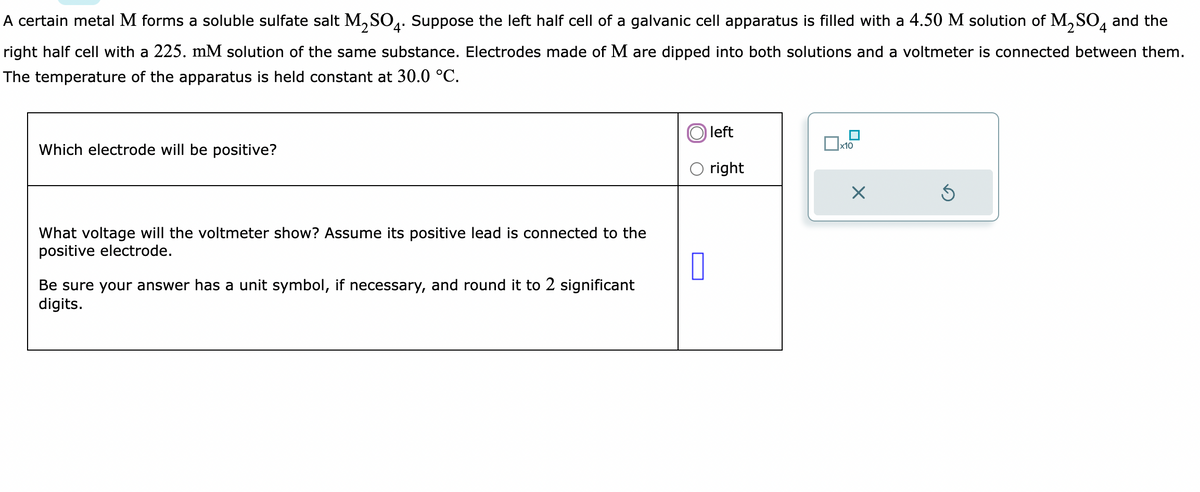A certain metal M forms a soluble sulfate salt M₂SO4. Suppose the left half cell of a galvanic cell apparatus is filled with a 4.50 M solution of M₂SO4 and the right half cell with a 225. mM solution of the same substance. Electrodes made of M are dipped into both solutions and a voltmeter is connected between them. The temperature of the apparatus is held constant at 30.0 °C. Which electrode will be positive? Oleft O right What voltage will the voltmeter show? Assume its positive lead is connected to the positive electrode. 0 Be sure your answer has a unit symbol, if necessary, and round it to 2 significant digits. 0x1² X
A certain metal M forms a soluble sulfate salt M₂SO4. Suppose the left half cell of a galvanic cell apparatus is filled with a 4.50 M solution of M₂SO4 and the right half cell with a 225. mM solution of the same substance. Electrodes made of M are dipped into both solutions and a voltmeter is connected between them. The temperature of the apparatus is held constant at 30.0 °C. Which electrode will be positive? Oleft O right What voltage will the voltmeter show? Assume its positive lead is connected to the positive electrode. 0 Be sure your answer has a unit symbol, if necessary, and round it to 2 significant digits. 0x1² X
General Chemistry - Standalone book (MindTap Course List)
11th Edition
ISBN:9781305580343
Author:Steven D. Gammon, Ebbing, Darrell Ebbing, Steven D., Darrell; Gammon, Darrell Ebbing; Steven D. Gammon, Darrell D.; Gammon, Ebbing; Steven D. Gammon; Darrell
Publisher:Steven D. Gammon, Ebbing, Darrell Ebbing, Steven D., Darrell; Gammon, Darrell Ebbing; Steven D. Gammon, Darrell D.; Gammon, Ebbing; Steven D. Gammon; Darrell
Chapter19: Electrochemistry
Section: Chapter Questions
Problem 19.118QP
Related questions
Question
C2.
Subject :- Chemistry

Transcribed Image Text:A certain metal M forms a soluble sulfate salt M₂SO4. Suppose the left half cell of a galvanic cell apparatus is filled with a 4.50 M solution of M₂SO4 and the
right half cell with a 225. mM solution of the same substance. Electrodes made of M are dipped into both solutions and a voltmeter is connected between them.
The temperature of the apparatus is held constant at 30.0 °C.
Which electrode will be positive?
What voltage will the voltmeter show? Assume its positive lead is connected to the
positive electrode.
Be sure your answer has a unit symbol, if necessary, and round it to 2 significant
digits.
0
left
right
x10
X
Ś
Expert Solution
This question has been solved!
Explore an expertly crafted, step-by-step solution for a thorough understanding of key concepts.
This is a popular solution!
Trending now
This is a popular solution!
Step by step
Solved in 3 steps with 1 images

Knowledge Booster
Learn more about
Need a deep-dive on the concept behind this application? Look no further. Learn more about this topic, chemistry and related others by exploring similar questions and additional content below.Recommended textbooks for you

General Chemistry - Standalone book (MindTap Cour…
Chemistry
ISBN:
9781305580343
Author:
Steven D. Gammon, Ebbing, Darrell Ebbing, Steven D., Darrell; Gammon, Darrell Ebbing; Steven D. Gammon, Darrell D.; Gammon, Ebbing; Steven D. Gammon; Darrell
Publisher:
Cengage Learning


Chemistry by OpenStax (2015-05-04)
Chemistry
ISBN:
9781938168390
Author:
Klaus Theopold, Richard H Langley, Paul Flowers, William R. Robinson, Mark Blaser
Publisher:
OpenStax

General Chemistry - Standalone book (MindTap Cour…
Chemistry
ISBN:
9781305580343
Author:
Steven D. Gammon, Ebbing, Darrell Ebbing, Steven D., Darrell; Gammon, Darrell Ebbing; Steven D. Gammon, Darrell D.; Gammon, Ebbing; Steven D. Gammon; Darrell
Publisher:
Cengage Learning


Chemistry by OpenStax (2015-05-04)
Chemistry
ISBN:
9781938168390
Author:
Klaus Theopold, Richard H Langley, Paul Flowers, William R. Robinson, Mark Blaser
Publisher:
OpenStax

Chemistry & Chemical Reactivity
Chemistry
ISBN:
9781337399074
Author:
John C. Kotz, Paul M. Treichel, John Townsend, David Treichel
Publisher:
Cengage Learning

Chemistry & Chemical Reactivity
Chemistry
ISBN:
9781133949640
Author:
John C. Kotz, Paul M. Treichel, John Townsend, David Treichel
Publisher:
Cengage Learning

Chemistry: Principles and Practice
Chemistry
ISBN:
9780534420123
Author:
Daniel L. Reger, Scott R. Goode, David W. Ball, Edward Mercer
Publisher:
Cengage Learning